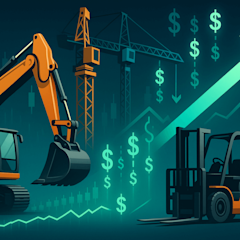
Preserve and Grow Your Wealth With Copper
As I’m sure you’re aware, we’re in the midst of another presidential election campaign. Plus, House and Senate races, and whatever else is happening in your neck of the woods. You either follow the news or you don’t, maybe because you’re sick of it all. But wherever you’re coming from, I promise…
We will not discuss current politics today. Instead, we’ll take a well-deserved break from the political discourse on this long holiday weekend and discuss geology and copper, meaning the metal, and why it’s critical to your investment future.

Look ahead five, 10, 15 and more years, and copper is worth your time to understand. It’s also worth your investment dollars. That is, over almost any frame of reference — near-term, intermediate or long-term — you can preserve wealth with copper, which offers limited downside for reasons I’ll explain in a moment. And you can grow your nest egg with copper too, again for reasons that I’ll lay out anon.
But first, let’s take a brief detour to Arizona.
The “Copper State”
Over the past couple of years, I’ve made numerous trips to Arizona, often as not to check out copper development projects, copper mines and old copper-mining history. In fact, I was recently out there again, in mid-August with temps well above 100 degrees. Yes, that’s hot, despite how people will tell you, “Oh, it’s just dry heat.” Yeah, right.
Dry or not, it’s a freaking furnace outside in the mid-summer, in southern Arizona. Still, there I was, in the field, shod in protective boots (note: carbon-fiber toes are far more comfortable than steel) and wearing long trousers, a long-sleeved shirt, reflective vest and a hard hat. I hiked through cactus, sagebrush and mesquite, walked along roadcuts and railbeds, climbed around outcrops, tried to avoid rattlesnakes, kicked rocks or whacked them with a hammer, and talked about geology with several superb copper guys from both industry and academe.
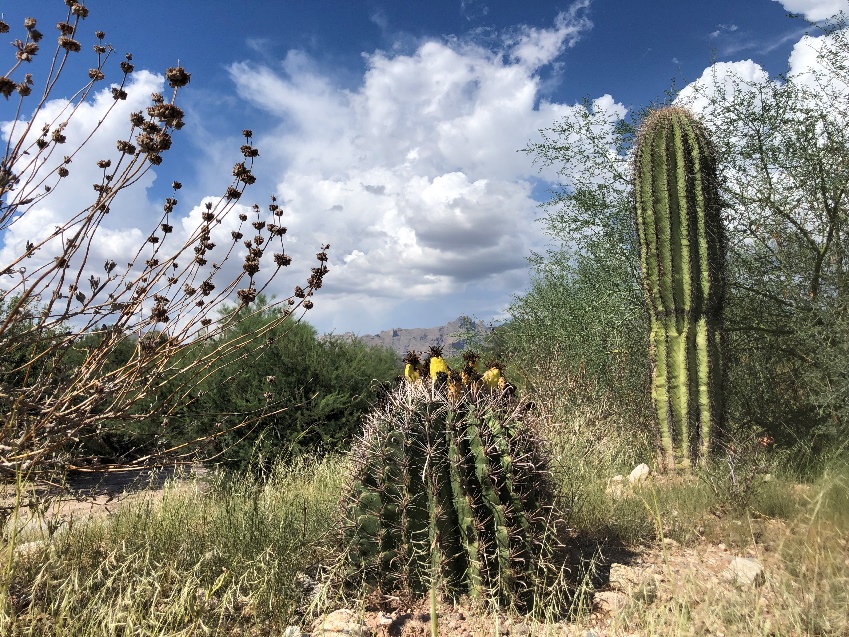
On the hunt for Arizona copper. BWK photo.
And do you know what? It’s just so much fun; hey, I love it!
The point is, Arizona is called the “copper state,” and for a good reason: the southern half is underlain by a complex geological assemblage of really old, pretty old, and kind of old rocks. These are all cut by fractures and faults, moved about by folding and other tectonic processes and intruded by super-hot magmas and other deep-earth systems that, over long stretches of geologic time, emplaced a lot of copper into the rocks, along with much else in the way of minerals and metals.
Just to give you a feel for Arizona’s copper systems, here's a map that identifies many past and present mine developments for the metal.

Courtesy University of Arizona.
Note that there are no red “copper” dots in the north, in the Colorado Plateau region. This is an area of massive uplifts, which led to the Colorado River carving the Grand Canyon. And to the extent that there’s copper in the deep rocks, it has not (yet) been exposed by erosion.
To be perfectly accurate, the lack of copper plays up north doesn’t mean that there’s no copper; in fact, the metal and its minerals are present in places in northern Arizona, but these are mostly smallish deposits of scientific and historical interest, and not large mineral systems and developments. Get down into the basement rock, and who knows what you’ll find.
Also to be perfectly accurate, this southern Arizona copper belt is part of a much larger set of geologic trends of continental scale, as you can see in this map.
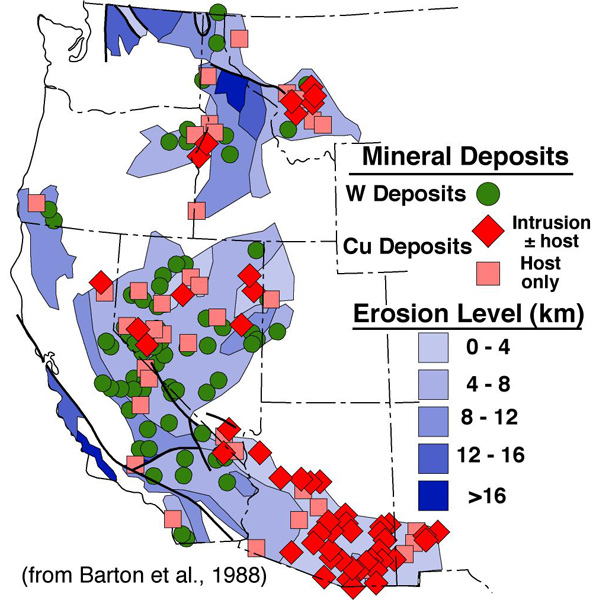
Courtesy University of Arizona.
Geologically, there’s much going on in terms of mineralization in what looks like an arc from northern Mexico, in Sonora state, through southern Arizona, wrapping up through California and Nevada, and then into Idaho and Montana. And this doesn’t even begin to describe the known, very impressive, mineral deposits and future potential in Utah, Colorado and more.
The point of all this is to focus on how the copper belt of southern Arizona is a region with significant uplift, plus extensive erosion over geologic time. In essence, this brought many formerly deeply buried copper deposits to the surface; or at least, in our time, close enough to prospect and discover.
So, copper is important to Arizona. And if you know a bit more about the place, you might recall the other “Cs” of the state, aside from its red metal output. That is, Arizona is well known for cattle, cotton, citrus and its wonderful climate in winter, far from the cold, wet, miserable weather back East.
The State That Almost Wasn’t
Pertinent to that last point, in the 1800s Arizona’s dry climate worked against it in terms of what people back East thought. The common view was that Arizona was a vast expanse of austere, desolate Western desert, essentially a long stretch of nothing in particular, except useless geography to cross over on the way to California.
To be fair to people of that era, they worked with limited knowledge; and actually, there were understandable reasons for their negative views of Arizona. As in yes, Arizona was definitely dry, and that certainly was the case in the long-ago days before modern water projects and massive irrigation. At best, back then, Arizona offered a physically challenging frontier life and lifestyle, including great danger from the tough-as-nails Apache who roamed the land.
Indeed, for these reasons and through most of the 1800s, Arizona was considered unfit to be admitted as a formal U.S. state. But time marches onward, and during the late 19th century the American West developed in its own way. And for many decades Arizona held the legal status of an American territory, little more than a national backwater. Except… the place had a lot of mineral wealth.
In the 1850s through about 1890s, the U.S. Army went about its business out West, often as not fighting the aforementioned Apache in Arizona. Along the way, observant soldiers noticed interesting, shiny minerals along the trails and rock faces. In many instances, the Army guys marked the locations on maps and brought specimens back to their camps and forts.
To make a long story short, more than a few of these Apache-fighting soldiers transformed into the original prospectors of the late 1800s who, either on their own or with the help of better geologic talent, found immense scales of valuable minerals outcropping across southern Arizona. One of the original, and in retrospect legendary, mineral discoveries was at a place called Bisbee, in the southeast part of the state.
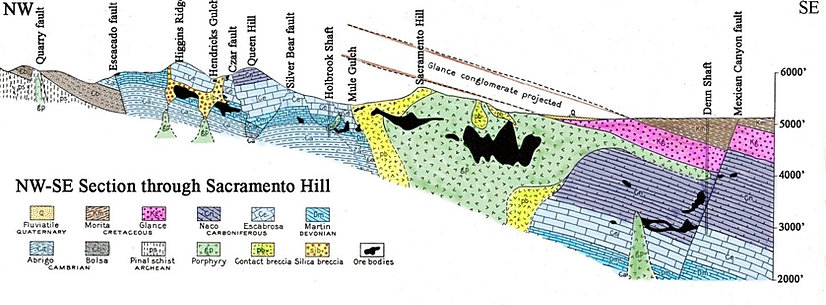
Geologic cross-section through Bisbee, Arizona copper deposits.
Around and beneath Bisbee is a Jurassic-age assemblage of copper mineralization, along with silver, gold and much else. The mineralization was high grade and extensive. All this, and many mineral specimens were stunningly beautiful, which led Arizona promoters to ship them across the U.S., and indeed the world. In this regard, Bisbee minerals played up the importance and wealth of Arizona.
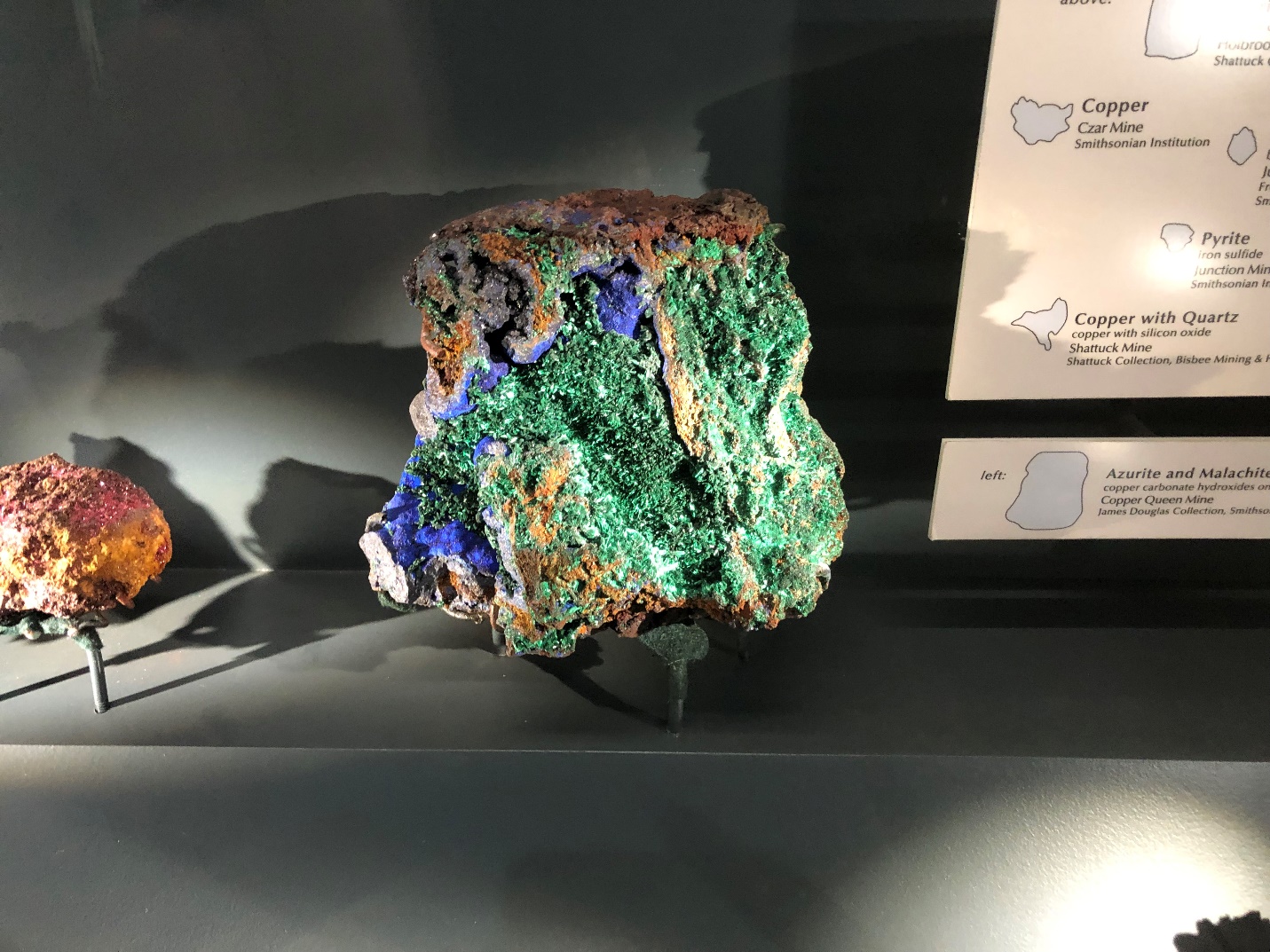
Bisbee malachite, azurite, cuprite.
Almost immediately, museums and collectors across America and the world began to acquire Bisbee specimens. Today, you’ll find Bisbee mineral examples in museums from Tokyo to St. Petersburg, and all across the U.S. from San Diego to the Smithsonian Institution.
Another way of saying it is that, from a promoter’s standpoint, Arizona might be dry, and much of the landscape may look like a desert, but the place was also a gigantic source of primary wealth, per its mineral endowment. And in no small part, this aggressive promotion of Arizona as a mineral district is what led to the territory becoming a U.S. state on Feb. 12, 1912.
The rest is history.
Copper, Then and Today
Of course, preceding the massive discoveries in Arizona, America already had a copper industry. It kicked into gear in the 1840s based on excellent ore deposits in the Upper Peninsula of Michigan.
Still, Michigan or no, America’s growing national economy required more and more of the red metal. And based on new discoveries out West, certainly with that of Bisbee in the 1880s and then spreading across other finds in the Arizona territory, copper mining grew in prolific fashion and became a key part of the U.S. national scale of industry.
Arizona’s copper mines, mills and smelters employed tens of thousands, and fed copper into the U.S. economy of the late 19th and early 20th centuries. Along the way, innumerable people accumulated (and some lost) immense fortunes.
Again, to make the point, America and the world needed copper during the country’s massive, initial period of industrialization, as towns and cities grew along with the population and trends towards urbanization. More and more, and affecting pretty much everyone, people needed copper for everything from household electric wire to telephones, house keys, doorknobs, plumbing and bathroom fixtures, and much else.
American industry also evolved and developed in ways that would have been impossible absent access to large amounts of relatively affordable copper. Consider obvious examples like the electric power industry, which requires copper at every stage from steam turbines to dynamos and generators, as well as wires and transformers. You’ll find copper everywhere along the way, from the power plant to the utility hookup and then all through the house or other buildings.
Just imagine the growing amounts of copper that went into everything from streetcar lines to steel mills; and if that’s not enough, consider the buildout of a national-scale telephone system.
Think of the iconic American business names that never could have worked out absent copper, used in a myriad of products: companies like General Electric and Westinghouse, or AT&T, RCA, Ford, General Motors, Chrysler, and countless more. Business histories are filled with accounts of CEOs and boards of directors plotting their companies’ fate based on the price of copper.
Really, when you open it all up, almost everything and every product uses copper. It’s as close as the wire in your house or place of work. Or the metal inside cars, trucks, trains, airplanes, ships, telephones, refrigerators, heating systems, air conditioning, building elevators, and on and on. Copper conducts the electricity that pumps water to your house or workplace, and then pumps the sewage away. It’s all based on copper; the metal is everywhere.
Along these last lines, and per the old saying, “water is life.” But take that a step further, to point out that electricity is quality of life; and copper is essential to conducting that electricity.
What’s Happening with Copper?
For all its importance to industry, however, over time copper has long been a cyclical business marked by booms and busts. Here’s a generalized view that goes back over a century, showing prices at the time (yellow line), as well as adjusted for inflation (blue line).
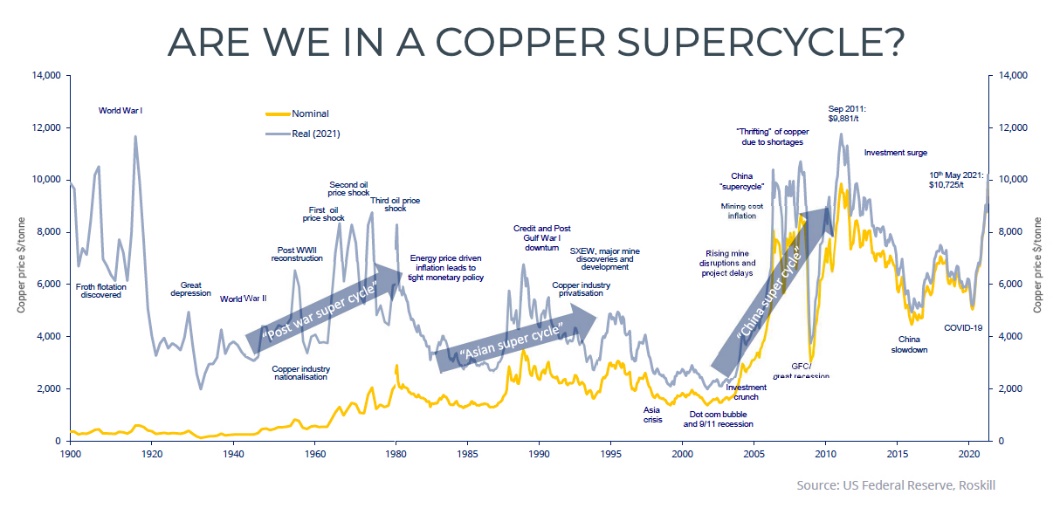
The takeaway here is to show how copper did well in the years post World War II, and during the Asia buildout in the 1970s-80s. Plus, look at how well copper performed during China’s expansion in the early 2000s.
What the chart doesn’t show, though, is baked-in future demand growth for copper, and inevitable shortages and price increases for the metal, all due to several reasons:
- The world is already in the midst of a general, copper-based electric power grid buildout from what we can just label as “normal” growth, as literally billions of people in the developing world move towards a better lifestyle.
- There’s a companion, copper-based grid rebuild in the developed world, certainly here in the U.S. where the country requires a dramatic reboot of the overall power complex, much of which goes back to the 1930s.
- We are fast moving towards a dramatic new increase in copper demand, in the U.S. and globally, to move electricity for applications that didn’t exist just a few years ago. In particular, this comes from demand growth in the arenas of artificial intelligence (AI), along with the ongoing move to power more and more new cars with electricity versus petroleum-based fuel.
Of course, there’s much more to the copper growth story, but for reasons of space, we’ll leave it at that. Meanwhile, it’s fair to say that the mining industry has lagged for many years in terms of exploration, discovery and investment in new copper mine projects. And this affects not just current supply, but future output. In other words, we’re staring down the barrel of strong worldwide growth in copper demand, but limited supplies.
Part of the reason for the lack of past investment was economics, in terms of weak or unsteady copper prices and unfavorable economics to finance new mines. Another angle has been the evolution of resource nationalism across the world, namely the increasing difficulty to obtain exploration concessions, social licenses, and permits to go out and explore. This issue is present in most nations across the globe. And to sum up, at root it’s just not very easy to explore, develop and operate in many regions and jurisdictions. (Long story.)
Back to the Future… of Copper
All of which brings us back to the beginning, and why copper is a solid investment idea now, and for many years to come. The downside is limited, in the sense that prices are firm as we look to enter a time of higher demand and weaker supplies from mines and mills. And the upside is apparent in a world where copper prices have been solid and are clearly getting stronger. It means that good, well-run companies will make money, impress Wall Street, and maintain dividends.
At this point, I must give a shout-out to one of the world’s great copper mining companies, Freeport McMoRan (FCX). Currently, shares trade in the $43-range, giving the company a market cap of over $62 billion. And it pays a dividend, about 1.8%.
Of interest, and pertinent to this article, Freeport is a new version of the old Phelps Dodge Company, which for many decades owned and operated a series of mines, now closed, at the aforementioned Bisbee site, in Arizona. Of course, Freeport has expanded over the decades. It runs mines in Arizona, elsewhere in the U.S., and overseas in Peru, Chile and Indonesia. The company produces copper, gold, silver and a host of other minerals and metals. And in a rising market for these metals, Freeport looks good in the years ahead.
Another company that works in the copper space is Rio Tinto (RIO), with shares trading now at about $62 and a market cap over $100 billion. Rio pays a dividend of over 6.5% yield, reflecting how it generates cash in this environment.
Rio operates in the U.S. and Canada, including owning the massive copper project at Bingham Canyon, Utah, as well as holding a solid interest in one of the best undeveloped copper plays in North America, at a site called Casino, in the Yukon where Rio works with Western Copper & Gold (WRN).
Rio is far more than copper, though. It mines iron ore in Australia, smelts aluminum in Canada, extracts zirconium in South Africa, and much else. The company has deep technical expertise in a variety of geological and engineering settings, and again is looking forward to meeting world needs in the period of strong demand that is unfolding.
I should note that although I love these companies as good investment opportunities, they won’t be tracked as part of the official portfolio here at Strategic Intelligence. But I do follow them and I’m always looking for news. If you buy in, be sure to use limit orders, look for down days in the markets, and never chase momentum.
And with all that, I’ll end here and thank you for subscribing and reading.
Want More Jim Rickards' Strategic Intelligence?
Do you like this content? Would you like to know more? Because we have this and much more to share with you. Get started today!









